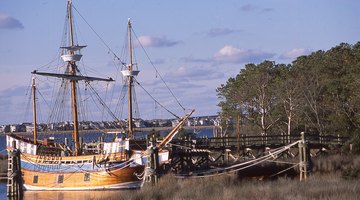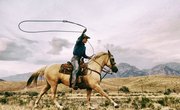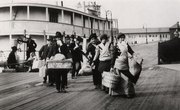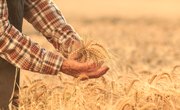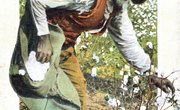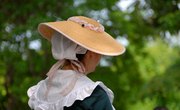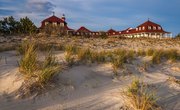In 1606, the Virginia Company of London sent ships across the sea in search of gold. The English settlers did not find gold in their settlement of Jamestown, but instead were stricken with starvation, disease and terrible suffering. Only 38 of 144 colonists managed to survive the first year in Jamestown. Pilgrims and Puritans came in the years that followed, and they, too, faced many hardships.
Colonial Settlements
On December 6, 1606, three ships left England to establish a settlement in Virginia. Over 100 men and boys arrived in Virginia in 1607. They selected a site for their new settlement and named it Jamestown. The settlers chose the site because it was surrounded by water on three sides and gave easy access to their ships. It was also far enough inland for settlers to ward off Spanish attacks. Years after their arrival, in 1620, Pilgrims came to New England. Poor weather forced them to land at Cape Cod instead of their original destination around the Hudson River in New York. Ten years later, in 1630, the Puritans settled in the town they named Boston. There, they formed the Massachusetts Bay Colony.
Sickness and Disease
This new land was home to germs, bacteria and diseases that the settlers had never encountered before. The Jamestown settlers built their settlement in a swampy location that lacked clean, healthy water. The water they drank was contaminated with human and animal waste. Seawater flowed into their wells, so many may have died from salt poisoning. Some colonists brought diseases, such as dysentery and typhoid, with them to Jamestown. Settlers lacked basic hygiene, so these diseases continued to spread and devastate the population. Pilgrims and Puritans had to cope with wet, cold weather. This may have caused diseases such as pneumonia and scurvy to run rampant. Some Puritans lost the use of their feet and fingers because it was so cold.
Starvation and Poor Diet
After their arrival in Jamestown, the settlers spent more time digging for gold than they did farming. As a result, the settlers didn't have enough food to last through the winter. The settlers ate anything they could find, including their horses, cats, dogs and rats. Leather from belts and shoes was also consumed. Some, in desperation, even dug up corpses and used the bodies as food. Pilgrim settlers were not as bad off, but they had a diet high in sea salt, which weakened and killed many. Two or three of them may have died each day for the first two months after their arrival. Puritans only had five months to grow crops between killing frosts. In some spots, the land was too stony or sandy to grow much food.
Indian Attacks
The Powhatan Indians generously supplied the settlers with food. Thanks to their gifts, the settlers survived the winter. Soon, though, the English began demanding more food, and this angered the Powhatan Indians. In 1622, Chief Opechancanough planned an attack on Jamestown in an effort to get rid of the settlers. About 400 settlers died in the attack. The English didn't leave, though. Instead, they fought back, and the fighting continued for 10 years. The Pilgrims had better luck with the Indians, since most of those in New England had been killed by an epidemic before they arrived. Remaining Indians and Pilgrims stayed friendly for years. In 1636, though, Massachusetts Bay Puritans started a war against the Pequot tribe. The Pilgrims were forced to joined the fray.
Related Articles
References
- National Park Service: A Short History of Jamestown
- Library of Congress: The English Establish a Foothold at Jamestown, 1601-1610
- Smithsonian.com: Starving Settlers in Jamestown Colony Resorted to Cannibalism
- History: Did Jamestown’s Settlers Drink Themselves to Death?
- U.S. History: 2c. Jamestown Settlement and the "Starving Time"
- National Park Service: Jamestown and Plymouth: Compare and Contrast
- Plimouth Plantation: Who Were the Pilgrims?
- Austin Community College District: A "New Paradise" for Puritans: Massachusetts Bay
Writer Bio
Melissa King began writing in 2001. She spent three years writing for her local newspaper, "The Colt," writing editorials, news stories, product reviews and entertainment pieces. She is also the owner and operator of Howbert Freelance Writing. King holds an Associate of Arts in communications from Tarrant County College.

